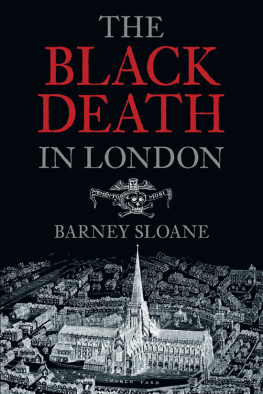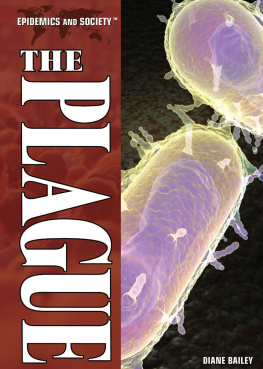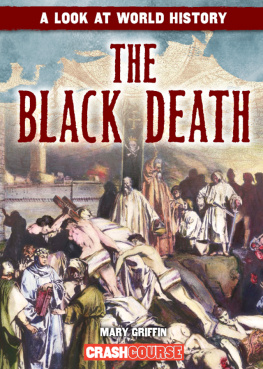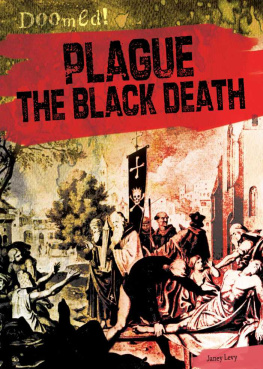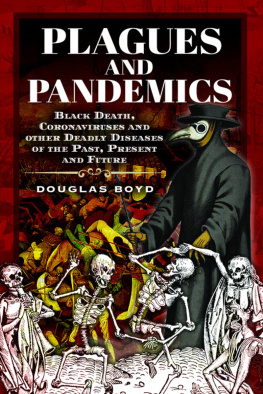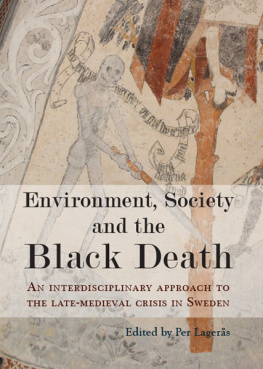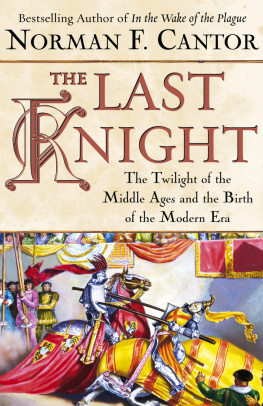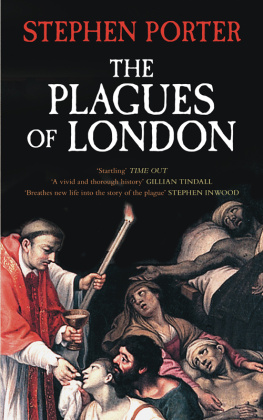THE
BLACK
DEATH
IN LONDON
THE
BLACK
DEATH
IN LONDON
BARNEY SLOANE

In the year of Our Lord 1349, a violent pestilence broke out beyond measure in the whole of the Kingdom of England, and especially in the City of London, where the people superabounded. So great a multitude eventually died that all the cemeteries of the aforesaid city were insufficient for the burial of the dead. For this reason, many were compelled to bury their dead in places unseemly, not hallowed or blessed; some, it was said, cast the corpses into the river.
Cover illustration: An engraving from An Introduction to English Church Architecture from the Eleventh to the Sixteenth Century (Volume 2) by Francis Bond.
First published 2011
The History Press
The Mill, Brimscombe Port
Stroud, Gloucestershire, GL5 2QG
www.thehistorypress.co.uk
This ebook edition first published in 2013
All rights reserved
Barney Sloane, 2011, 2013
The right of Barney Sloane to be identified as the Author of this work has been asserted in accordance with the Copyrights, Designs and Patents Act 1988.
This ebook is copyright material and must not be copied, reproduced, transferred, distributed, leased, licensed or publicly performed or used in any way except as specifically permitted in writing by the publishers, as allowed under the terms and conditions under which it was purchased or as strictly permitted by applicable copyright law. Any unauthorised distribution or use of this text may be a direct infringement of the authors and publishers rights, and those responsible may be liable in law accordingly.
EPUB ISBN 978 0 7524 9639 9
Original typesetting by The History Press
CONTENTS
FOREWORD
T HE FIRST onslaught of the Black Death in 134753 remains the greatest single catastrophe to have struck mankind in recorded history. A vast literature exists which examines and often vigorously debates its origins, its causes and its impacts on cities and manors, on economies and society, and on the very beliefs held by people over 600 years ago. Internationally, two major recent studies, Ole Benedictows The Black Death 134753:A Complete History and Sam Cohns The Black Death Transformed, set both the European stage and readily demonstrate the vigour of the debate.
As a professional archaeologist, I came face to face with the effects of the epidemic on London during excavations at the Black Death cemetery of East Smithfield near the Tower of London, which unearthed hundreds of skeletons of the victims. But remarkably, given the relative abundance of its documentary records, the detailed story of how London succumbed, suffered and eventually adapted to this awful disease has never been told. This attempt to fill that gap reveals some rather surprising aspects of the citys reaction to the plague, it raises some fundamental questions about the level of mortality and it examines the later outbreaks (1361, 1368 and 1375) that dogged the reign of Edward III to set out comparisons and contrasts with the first terrible blow.
This book is not specifically about the causes of the plague, its identification with one or another pathogen, or the science of its spread (although a summary of current debate is provided). Rather, it has been my aim to develop a detailed historical narrative from documents and archaeology to provide as complete an understanding of the horrifying test to which the nations capital was put. I hope that this analysis provides a springboard for further research into the impact of the Black Death on London. This is an essentially human story populated with many names of real people who came face to face with one of our worst nightmares and lived, or died, in London more than six centuries ago.
Barney Sloane
ACKNOWLEDGEMENTS
I WISH to thank specific organisations, friends and colleagues who have helped me considerably in the development of this book. First and foremost I would like to acknowledge a debt of gratitude to Caroline Barron (Royal Holloway) who provided encouragement and many very helpful suggestions in developing the text. Christopher Phillpotts reviewed and transcribed the relevant surviving manorial documents for Stepney. Claire Martin and Jeremy Ashbee gave their valuable time to undertake further examination and transcription of original documents. For further contributions to the historical research, I would like to thank Dr Mark Forrest for sharing his data on Gillingham in advance of publication. Ann Causton, Robert Braid, Sam Cohn, Graham Dawson and Penny Tucker provided further help. I have benefited greatly from the generosity of archaeologists involved in the excavation or analysis of material from this period, and here I would very much like to thank Ian Grainger and Chris Thomas of the Museum of London Archaeology, the late Bill White of the Centre for Human Bioarchaeology at the Museum of London, and Dr Sharon DeWitte (Albany University). For additional advice in structuring the text and contents I record my gratitude to Professor Roberta Gilchrist (University of Reading), and Dr John Clark (Museum of London); and for helpful comments I would like to thank Jenni Butterworth, Nathalie Cohen, Peter Mills, and Professor James Wood.
ABREVIATIONS
Arch J | Archaeological Journal |
CAD | H.C.M. Lyte (ed.), 1915, A Descriptive Catalogue of Ancient Deeds, Vol. 6 (London) |
CAN | H. Chew & W. Kellaway (eds), 1973, London assize of nuisance 13011431: A calendar |
CCR | Calendar of Close Rolls |
CCRBL | W.H. Turner, 1878, Calendar of Charters and Rolls preserved in the Bodleian Library (Oxford) |
CCRC | R.R. Sharpe (ed.), 1913, Calendar of the Coroners Rolls of the City of London AD 13001378 (London) |
CFR | Anon, 1921, Calendar of the Fine Rolls preserved in the Public Record Office, Volume VI, Edward III, 134756 (London) |
CHW | R.R. Sharpe (ed.), 1889, 1890, Calendar of wills proved and enrolled in the Court of Husting 12581688, 2 Vols (London) |
CIPM | H.C.M Lyte (ed.), 1916, Calendar of Inquisitions Post Mortem, Vol. IX, Edward III (London) |
CLB F | R.R. Sharpe (ed.), 1904, Calendar of Letter-books preserved among the archives of the corporation of the City of London: Letter-book F c. AD 13371352 (London) |
CLB G | R.R. Sharpe (ed.), 1905, Calendar of Letter-books preserved among the archives of the corporation of the City of London: Letter-book G c. AD 13521374 (London) |
CLB K | R.R. Sharpe (ed.), 1911, Calendar of Letter-books preserved among the archives of the corporation of the City of London: Letter-book K Temp Henry VI (London) |
CLPA | H. Chew (ed.), 1965, London Possessory Assizes: a calendar (London Rec Soc Vol. I) |
CPL | W.H. Bliss & C. Johnson, 1897, Calendar of entries in the Papal Registers relating to Great Britain and Ireland: Papal Letters, Vol. 3, AD 13421362 (London) |
CPMR | A.H. Thomas (ed.), 1926, Calendar of the Plea and Memoranda Rolls of the City of London, Vol. I, 13231364 |
CPP | Calendar of Papal Petitions |
CPR | Calendar of Patent Rolls |
Next page
